Guide to Qualifying New Suppliers in Malaysia for Manufacturing Success
Malaysia is a premier manufacturing hub in Southeast Asia. According to the Malaysian Investment Development Authority (MIDA), “Malaysia, with its extensive trade....
By AMREP | Posted on August 21, 2025
In the electronics industry, the success of a product depends not only on its hardware design but also on the quality and reliability of its firmware and functional performance. As devices become more complex and interconnected, thorough testing has become essential to ensure functionality, safety, and user satisfaction.
This guide covers what firmware and functional testing are, why they matter, common testing methods, best practices, and the tools used in modern electronics manufacturing.
Firmware is the embedded software programmed into an electronic device’s non-volatile memory, such as flash or EEPROM. It controls the hardware and ensures the product functions as intended. Unlike general-purpose software, firmware operates close to the hardware level and often manages critical tasks such as:
Example: In a smart thermostat, firmware controls temperature sensing, regulates HVAC systems, manages Wi-Fi connectivity, and processes user inputs from a mobile app.
Firmware testing is the process of verifying that the embedded software works correctly under all intended conditions. It ensures that:
Key goals: Identify bugs early, reduce field failures, and ensure compliance with regulatory standards.
Functional testing verifies that an electronic device’s hardware and firmware work together as intended. Unlike firmware-only testing, it focuses on the complete product, checking:
Example: In a wearable fitness tracker, functional testing would verify that step counting is accurate, heart rate readings are correct, Bluetooth pairing works, and battery life meets specifications.
| Aspect | Firmware Testing | Functional Testing |
|---|---|---|
| Focus | Embedded software logic | Overall product performance |
| Scope | Code validation, algorithm correctness | Hardware-firmware integration |
| Environment | Simulators, emulators, and test boards | Actual production units or prototypes |
| Goal | Ensure code correctness | Ensure product meets functional requirements |
Effective firmware testing uses a mix of techniques to validate code correctness, reliability, and performance. The following methods are commonly applied in electronics development and manufacturing:
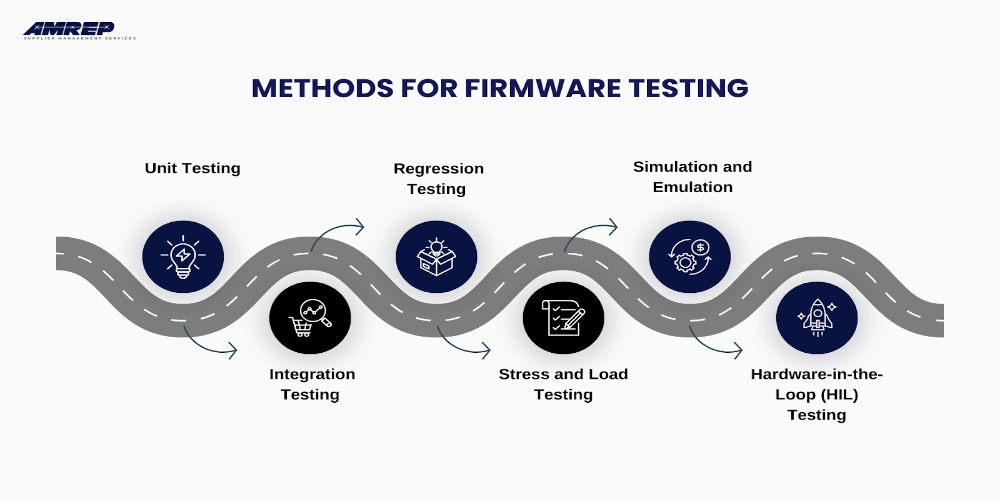
This involves testing individual functions or modules of the firmware in isolation. It ensures that each small section of code works as expected before integrating it with the rest of the system. Unit tests are often automated and run every time new code is added or modified.
Once individual modules pass unit testing, they are combined and tested together. Integration testing checks how different firmware components interact and ensures that data flows correctly between modules, avoiding issues like mismatched data types or incorrect timing.
Whenever firmware is updated, there’s a risk that new changes might break existing features. Regression testing re-runs previously passed test cases to confirm that old functionalities still work as intended after code modifications.
This method evaluates firmware performance under extreme or continuous workloads. It helps identify memory leaks, buffer overflows, or performance bottlenecks that could cause failures in real-world usage.
Before hardware prototypes are available, developers can use simulators and emulators to run firmware in a virtual environment. This speeds up early testing, allows debugging without damaging hardware, and helps verify behavior in controlled scenarios.
HIL testing connects the firmware to real or simulated hardware components to evaluate how it performs with physical inputs and outputs. This is particularly useful for safety-critical applications like automotive electronics or industrial control systems.
Functional testing in electronics ensures that the final product works as intended under real-world conditions. Below are the most common methods, each serving a specific purpose in validating device performance.
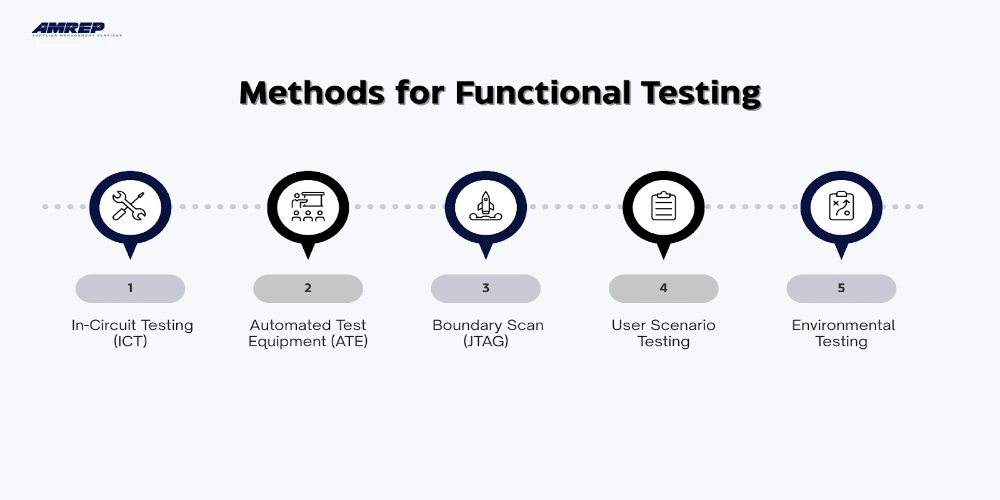
ICT checks the integrity of a printed circuit board (PCB) at the component level. It verifies solder joints, connections, and basic components like resistors, capacitors, and ICs. This test helps identify early-stage defects such as poor soldering or faulty components before the device moves to full system testing.
ATE systems are designed to perform electrical and functional tests automatically, making them ideal for high-volume production. These systems measure voltage, current, and signal responses to confirm that circuits operate within specification. ATE reduces human error, speeds up testing, and ensures consistency across large batches of products.
Boundary scan, based on the JTAG standard, allows testing of interconnects between integrated circuits without needing physical probes. It’s especially useful for densely packed PCBs where direct probing is difficult. Engineers can use boundary scan to check data paths, detect open circuits, and confirm chip-to-chip communication.
This method simulates how a customer will actually use the product. It involves running real-world scenarios such as powering on the device, pairing with other systems, or executing specific functions. For example, a smartphone might undergo scenario tests for calling, charging, or connecting to Wi-Fi. This helps catch functional issues that lab-only tests may miss.
Electronics are often exposed to different environmental conditions, so functional testing also includes stress tests under temperature extremes, humidity, vibration, and shock. For instance, automotive electronics are tested to ensure they perform reliably in both freezing and high-heat conditions. This step ensures long-term durability and compliance with industry standards.
Testing firmware and functionality in electronics requires specialized tools that can capture signals, analyze performance, and automate checks. Below are the most commonly used tools and their roles:
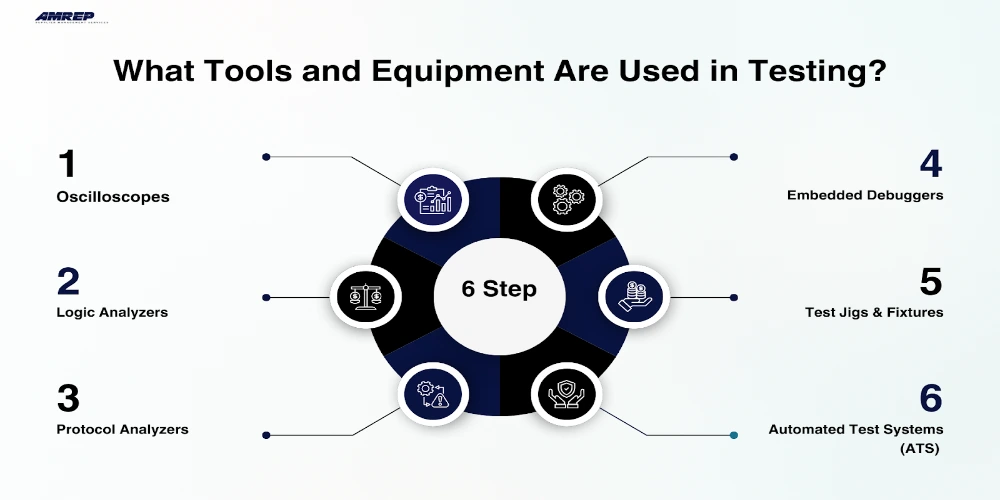
Oscilloscopes are essential for visualizing electrical signals in real time. They allow engineers to measure voltage levels, timing, and waveforms to confirm that circuits behave as expected. For example, an oscilloscope can detect noise on a power line or verify that a clock signal is stable.
Logic analyzers are used to capture and analyze multiple digital signals at once. They help engineers troubleshoot timing issues, protocol errors, and communication problems in digital circuits. This is especially useful in systems where several signals interact, such as microcontrollers or memory buses.
Protocol analyzers check the performance of communication standards like I2C, SPI, UART, USB, and Ethernet. They decode data packets, identify transmission errors, and verify whether devices are following the correct communication protocol. This ensures reliable connectivity between components.
Debugging tools like JTAG and Serial Wire Debug (SWD) provide low-level access to microcontrollers. They allow developers to pause execution, step through firmware code line by line, and inspect variables or memory contents. This is critical for finding bugs in embedded software before deployment.
Test jigs and fixtures are custom setups that hold a device in place and connect it to test equipment. They are widely used in manufacturing to perform repetitive tests quickly and consistently. For example, a jig may be designed to apply power, connect probes, and run functional checks on hundreds of units per day.
Automated Test Systems integrate multiple instruments, software, and fixtures into a single platform to perform complex test sequences. ATS is commonly used in large-scale production to ensure every unit meets quality standards. It improves efficiency, reduces human error, and provides consistent data across batches.
Thorough testing is essential to ensure that electronic products are reliable, safe, and ready for real-world use. Following structured best practices helps reduce defects, speed up development, and improve product quality.
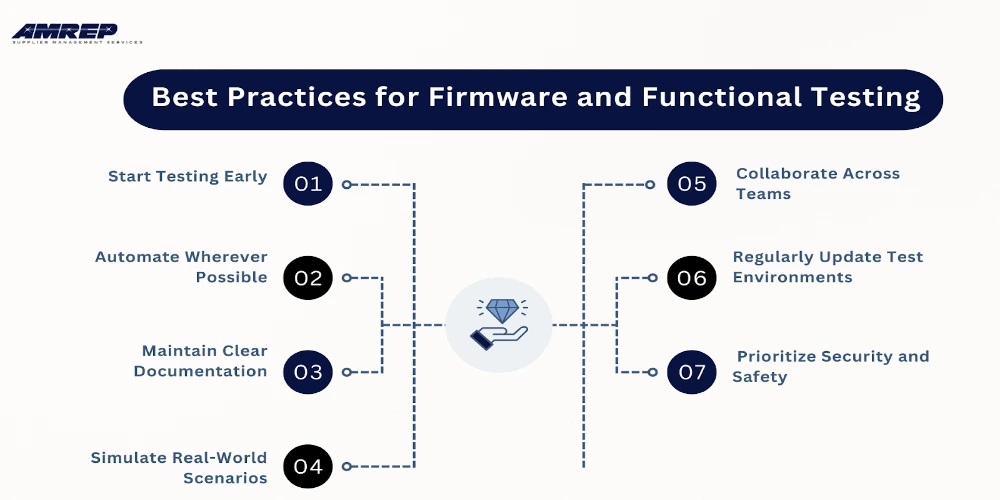
Incorporate testing from the design stage rather than leaving it until after development. Early validation helps catch design flaws, firmware bugs, or integration issues before they become costly to fix.
Automated testing tools and scripts can repeatedly run test cases with accuracy and speed. This is especially important for regression testing, where each new firmware update must be verified against existing functions.
Every test case, procedure, and result should be properly documented. Clear records not only improve traceability but also help teams diagnose issues faster and meet regulatory compliance requirements.
Testing should not be limited to lab conditions. Simulating real-world use cases, such as power interruptions, extreme temperatures, or unexpected user inputs, ensures the product performs reliably outside controlled environments.
Firmware, hardware, and QA teams must work closely together. Shared feedback loops help identify issues at the intersection of hardware and software, which is where many failures occur.
As firmware evolves, testing environments, fixtures, and automation scripts should also be updated. Using outdated test setups may overlook new bugs or compatibility issues introduced in the latest builds.
With connected devices and IoT systems, security is just as important as functionality. Include tests for data protection, firmware update integrity, and fail-safe mechanisms in case of unexpected errors.
As electronic devices become more advanced and interconnected, testing them thoroughly presents new difficulties. Below are some of the most common challenges companies face today.
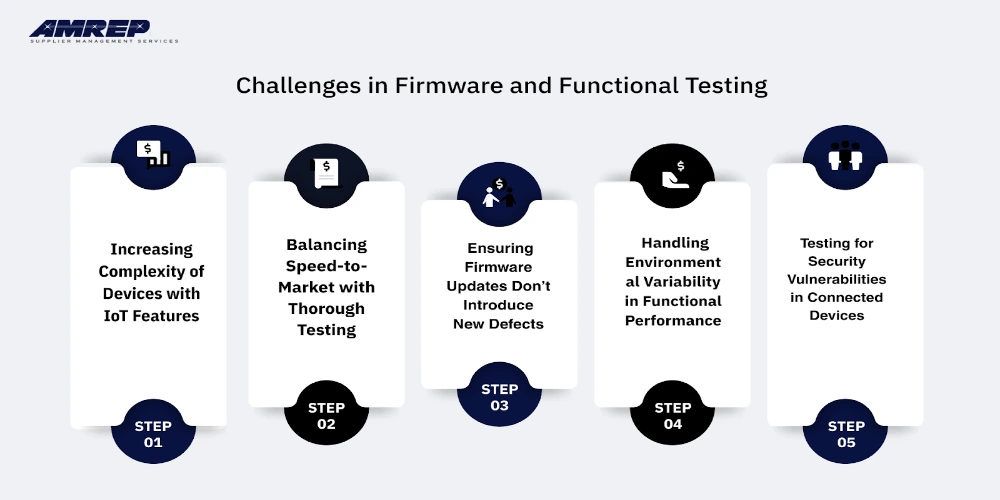
Modern devices often include wireless connectivity, cloud integration, and multiple sensors. This makes firmware development and testing more complex, since each module must work correctly on its own and in combination with others. Ensuring seamless communication across different protocols (Wi-Fi, Bluetooth, Zigbee, etc.) adds another layer of testing difficulty.
Companies face constant pressure to release products quickly, especially in consumer electronics where innovation cycles are short. However, rushing to market can result in incomplete testing and undetected issues. Striking the right balance between thorough validation and meeting launch deadlines remains a major challenge.
Many products now rely on over-the-air (OTA) firmware updates to fix bugs or add new features. While convenient, each update risks introducing new defects or breaking existing functions. Regression testing is essential, but running it thoroughly for every update consumes time and resources.
Electronics are used in diverse environments, from hot, humid regions to cold or dusty conditions. Functional testing must account for these variables, but replicating all possible real-world environments in a lab setting is difficult. This can lead to gaps in test coverage and unpredictable failures in the field.
With the rise of IoT, security has become a critical aspect of functional testing. Firmware must be validated against threats like unauthorized access, data leaks, and malware injections. Many companies struggle to integrate cybersecurity testing into traditional QA processes, leaving products vulnerable once deployed.
These challenges often stem from supplier partnerships, as we explain in our blog on Common Problems with Contract Manufacturers and How to Solve Them.
For manufacturers, delivering a product that works flawlessly is critical to brand reputation and long-term success. Firmware and functional testing play a central role in achieving this.
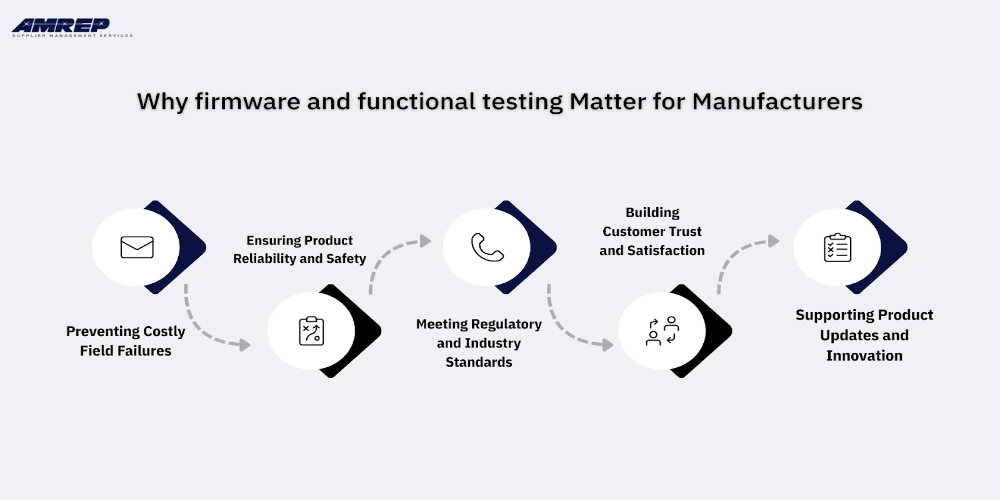
Undetected firmware bugs or hardware–software integration issues can lead to product recalls, warranty claims, and expensive repairs. Thorough testing during development and production helps catch these issues early, saving both money and reputation.
Electronics often operate in environments where safety and reliability are essential, such as automotive systems, medical devices, or industrial equipment. Testing ensures that devices perform consistently under different conditions and that fail-safe mechanisms activate when needed.
Many industries have strict compliance requirements, such as ISO, IEC, or FDA standards. Robust firmware and functional testing provide the documented evidence manufacturers need to demonstrate compliance, which is essential for market approval.
Consumers expect devices to work right out of the box. Frequent malfunctions or software glitches can quickly erode trust and damage a brand. Well-tested products reduce returns, improve customer satisfaction, and encourage repeat business.
With many electronics now relying on firmware updates, testing ensures new features can be rolled out without breaking existing functionality. This allows manufacturers to innovate confidently while maintaining product stability.
As electronics manufacturing continues to expand across Asia, countries like Thailand are gaining attention for their strong industrial growth. Explore more in our blog on Why Thailand Is Emerging as a Top Manufacturing Hub in Asia.
Firmware and functional testing are critical pillars of modern electronics manufacturing. Firmware testing ensures that the embedded code works correctly, while functional testing confirms that the final product performs as intended in the real world.
At AMREP Inspect, we know that every successful electronic product begins with trust in its performance. Our expertise in firmware and functional testing, combined with robust Product Quality Management practices, ensures that your devices meet the highest standards of quality, reliability and compliance. By partnering with us, manufacturers gain the confidence to launch products faster, reduce costly failures, and strengthen their reputation in the global market. With AMREP Inspect, you don’t just test your products, you secure their success.
Contact Us To See What We Can Do
Call Us
Mon - Sat 9.00 - 18.00
Sunday Closed


12 - May 2025
12
May
2025
Malaysia is a premier manufacturing hub in Southeast Asia. According to the Malaysian Investment Development Authority (MIDA), “Malaysia, with its extensive trade....

22 - April 2025
22
April
2025
Healthcare is rapidly evolving, ensuring consistent and high-quality patient care. Total Quality Management (TQM) in healthcare is more than just a buzzword—it is a powerful....

16 - April 2025
16
April
2025
Total Quality Management (TQM) is a mindset that involves everyone in the organization working toward a common goal: achieving excellence through quality. From....
